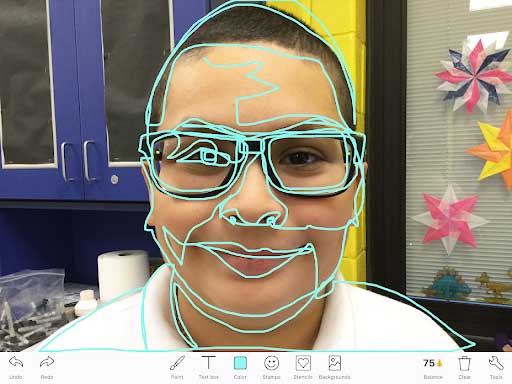As a choice-based educator, I expect my students to generate artistic ideas on their own. Understandably, this can be a very challenging task for many of them. My lesson about the body is intended to inspire my students to begin an artistic investigation that engages and excites them. I teach this unit to my elementary students who are between the ages of six and eleven, but this theme can be modified to suit students of any age.
The body is a great starting point for teaching art to young students because they still have the profound desire to make-believe, to tell stories, to adorn, to dress up, and to play. I think that if a group of students is left alone in an art studio with an assortment of colorful papers, scissors, and tape, the papers will inevitably be transformed into costumes taped onto their little bodies. This unit harnesses the penchant for play that my students naturally have in the art studio. Sharing videos and images of more established artists who use similar techniques helps to validate the students’ direction, confirming that what they are making is indeed art.
I start the unit with a short discussion about art in relation to the body, prompted by the following questions:
- What can we create that can be worn on the body?
- What can we create that can be made with the body?
- What can we create that can be about the body?
I consider these questions to be invitations to artmaking. I tell my students that they don’t have to use the body in their ideas. I ask them to consider ways in which the body might lead to an interesting idea, and I hope that they will stumble upon ideas either during our discussion or during their time experimenting with materials in the studio.
Nick Cave, performing a “Soundsuit,” 2016. Production still from the Art in the Twenty First Century Season 8 episode, “Chicago.” © Art21, Inc. 2016.
We look at and discuss the works of various artists. One example is Cyrus Kabiru and how he uses recycled objects to make wearable sculptures. Since we also have recycled objects in our studio, how can we create something with those materials that we can wear? We analyze the work of Nick Cave: what materials are utilized in his soundsuits, and why do those materials work well for his artistic ideas? Like Cindy Sherman, who transforms her body into a wide cast of different characters, how can we become transformed by our art? As we discuss these artists and images of their works, the students generate two lists in their sketchbooks. The first lists are of possible materials for this artmaking investigation, prompted by asking: what materials in our studio can be used to make something that can be worn on the body? These lists contain items like painted papers, feathers, beads, yarn, and cardboard. The second lists are composed of artistic ideas that the students have already begun to envision, like ideas for jewelry, hats, capes, and masks. We are always discussing the fact that artists generate ideas and that they must choose the materials that work best for their ideas.
Cindy Sherman in front of her staged self portrait. Production still from the Art in the Twenty First Century Season 5 episode, “Transformation.” © Art21, Inc. 2009.
“With younger students, ideas are often driven by interaction with materials that are laid out before them.”
My students are allowed time to experiment with materials and techniques as they seek an idea that excites them. Giving them this time encourages organic inspiration. In our open studio, there is always a variety of two- and three-dimensional materials available to choose from. Especially with younger students, ideas are often driven by interaction with materials that are laid out before them; the materials become the inspiration for the idea. Each section of the room is designated for a different group of materials, and the students know how to access those materials. For example, if a student needs yarn, fabric, and beads for their idea, they know that they would find those materials in our fiber studio. After students have had a chance to experiment with materials, they can work alone or with a team of collaborators, often with little guidance from me.
For students who struggle to generate ideas, simple creative prompts about the body can guide our ideation conversation while providing the opportunity for very divergent outcomes. (Two examples: What are we interested in creating that is related to the body? What materials can we use in order to create something that is related to the body?) The students should also be able to communicate how they think their idea connects to the prompt.
Creative Growth Art Center, artist on stage at the annual runway event “Beyond Trend,” 2018. Production still from the Art in the Twenty First Century Season 9 episode, “San Francisco Bay Area.” © Art21, Inc. 2018.
The students are allowed a few weeks to give and get feedback while they work on and refine their artistic ideas relating to the body. As they are working, I often tell my students that art takes time. During each of these working classes, we pause to discuss the work of contemporary artists who are making art that has a connection to the body. In the Art21 clip of Creative Growth Art Center’s annual fashion show, we learn that many of the artists are making the clothes they are going to wear for up to two years. From that clip, my students get a chance to see the happiness and joy that comes from celebrating artistic achievements; I want my students to feel equally excited about the work that they create in our art class. This teaching unit shows that art that is about the body or that can be worn on the body has a special way of activating young artists and getting them excited about creating art.
